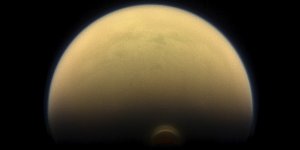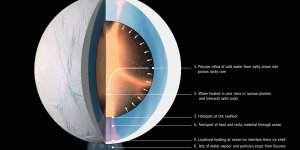| News / Space News |
Jupiter’s Jet-Streams Are Unearthly
Data collected by NASA’s Juno mission to Jupiter indicate that the atmospheric winds of the gas-giant planet run deep into its atmosphere and last longer than similar atmospheric processes found here on Earth.

This composite image, derived from data collected by the Jovian Infrared Auroral Mapper (JIRAM) instrument aboard NASA’s Juno mission to Jupiter, shows the central cyclone at the planet’s north pole and the eight cyclones that encircle it. Image credit: NASA/JPL-Caltech/SwRI/ASI/INAF/JIRAM
Juno’s measurement of Jupiter’s gravity field indicates a north-south asymmetry, similar to the asymmetry observed in its zones and belts.
On a gas planet, such an asymmetry can only come from flows deep within the planet; and on Jupiter, the visible eastward and westward jet streams are likewise asymmetric north and south. The deeper the jets, the more mass they contain, leading to a stronger signal expressed in the gravity field. Thus, the magnitude of the asymmetry in gravity determines how deep the jet streams extend.
The result was a surprise for the Juno science team because it indicated that the weather layer of Jupiter was more massive, extending much deeper than previously expected. The Jovian weather layer, from its very top to a depth of 1,900 miles (3,000 kilometers), contains about one percent of Jupiter’s mass (about 3 Earth masses).
By contrast, Earth’s atmosphere is less than one millionth of the total mass of Earth. The fact that Jupiter has such a massive region rotating in separate east-west bands is definitely a surprise.
Another Juno result suggests that beneath the weather layer, the planet rotates nearly as a rigid body. This is really an amazing result, and future measurements by Juno will help us understand how the transition works between the weather layer and the rigid body below.
A truly striking result released in the Nature papers is the beautiful new imagery of Jupiter’s poles captured by Juno’s Jovian Infrared Auroral Mapper (JIRAM) instrument.
Imaging in the infrared part of the spectrum, JIRAM captures images of light emerging from deep inside Jupiter equally well, night or day. JIRAM probes the weather layer down to 30 to 45 miles (50 to 70 kilometers) below Jupiter’s cloud tops.
Jupiter’s poles are a stark contrast to the more familiar orange and white belts and zones encircling the planet at lower latitudes. Its north pole is dominated by a central cyclone surrounded by eight circumpolar cyclones with diameters ranging from 2,500 to 2,900 miles (4,000 to 4,600 kilometers) across.
Jupiter’s south pole also contains a central cyclone, but it is surrounded by five cyclones with diameters ranging from 3,500 to 4,300 miles (5,600 to 7,000 kilometers) in diameter. Almost all the polar cyclones, at both poles, are so densely packed that their spiral arms come in contact with adjacent cyclones.
However, as tightly spaced as the cyclones are, they have remained distinct, with individual morphologies over the seven months of observations. (NASA)
YOU MAY ALSO LIKE





